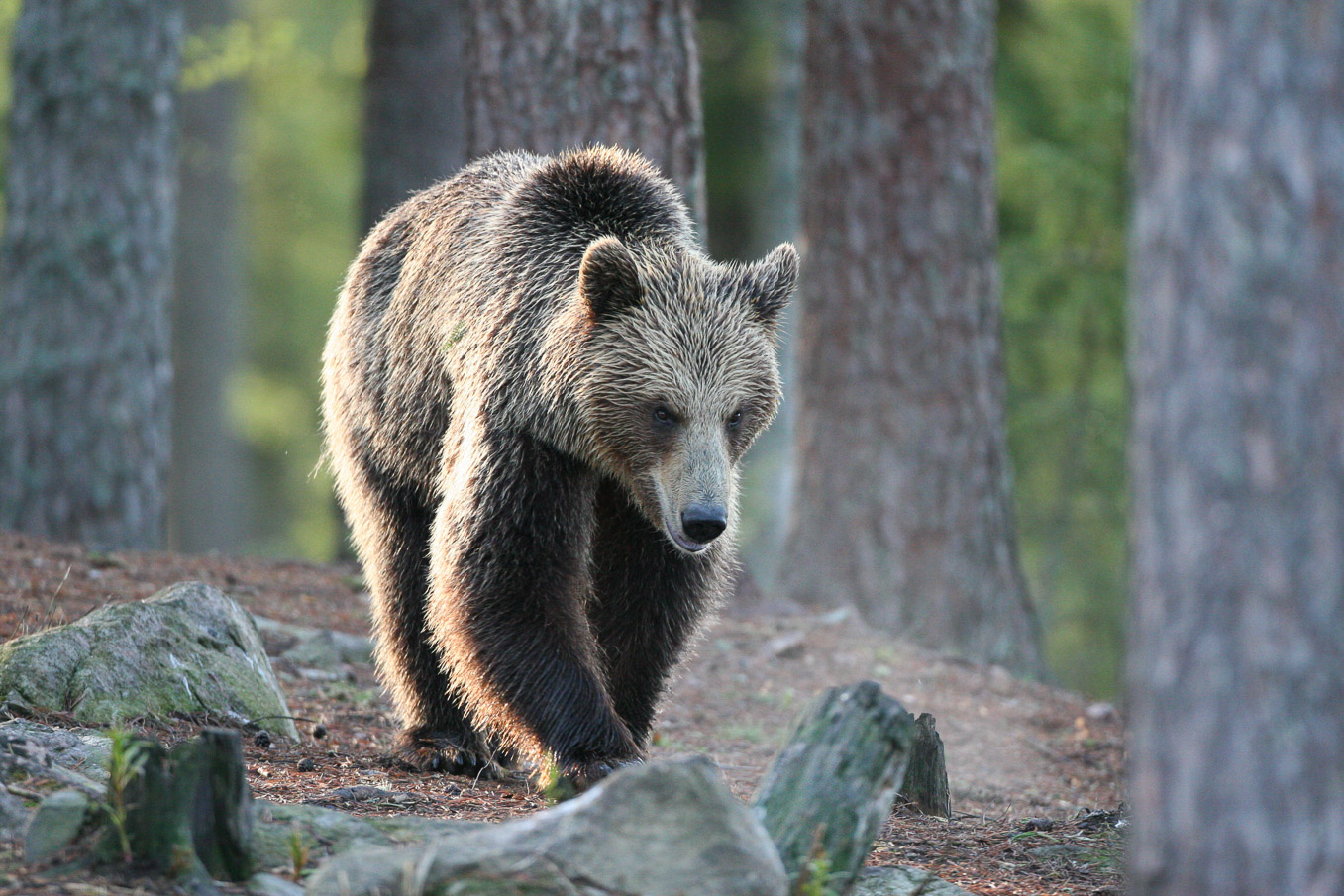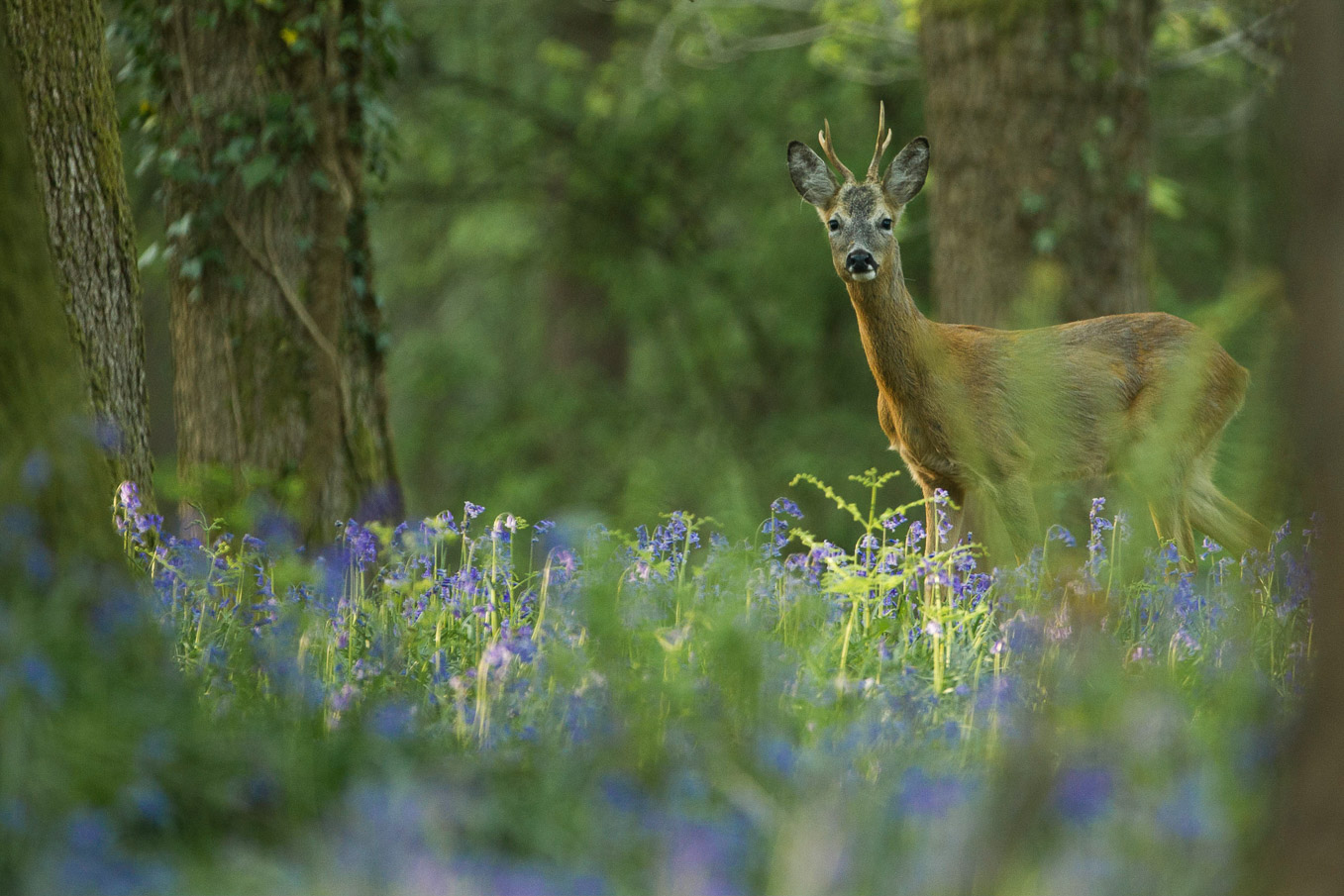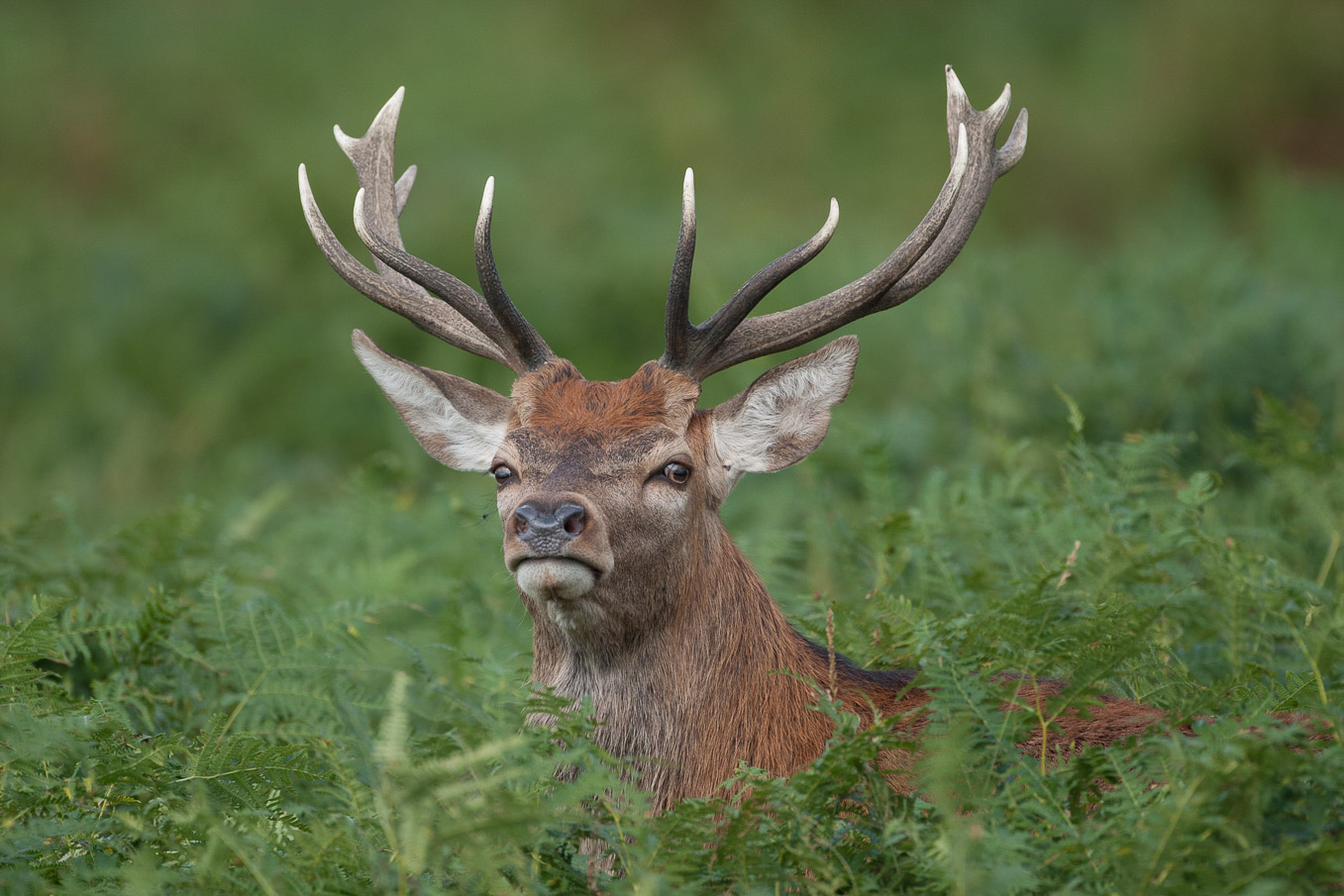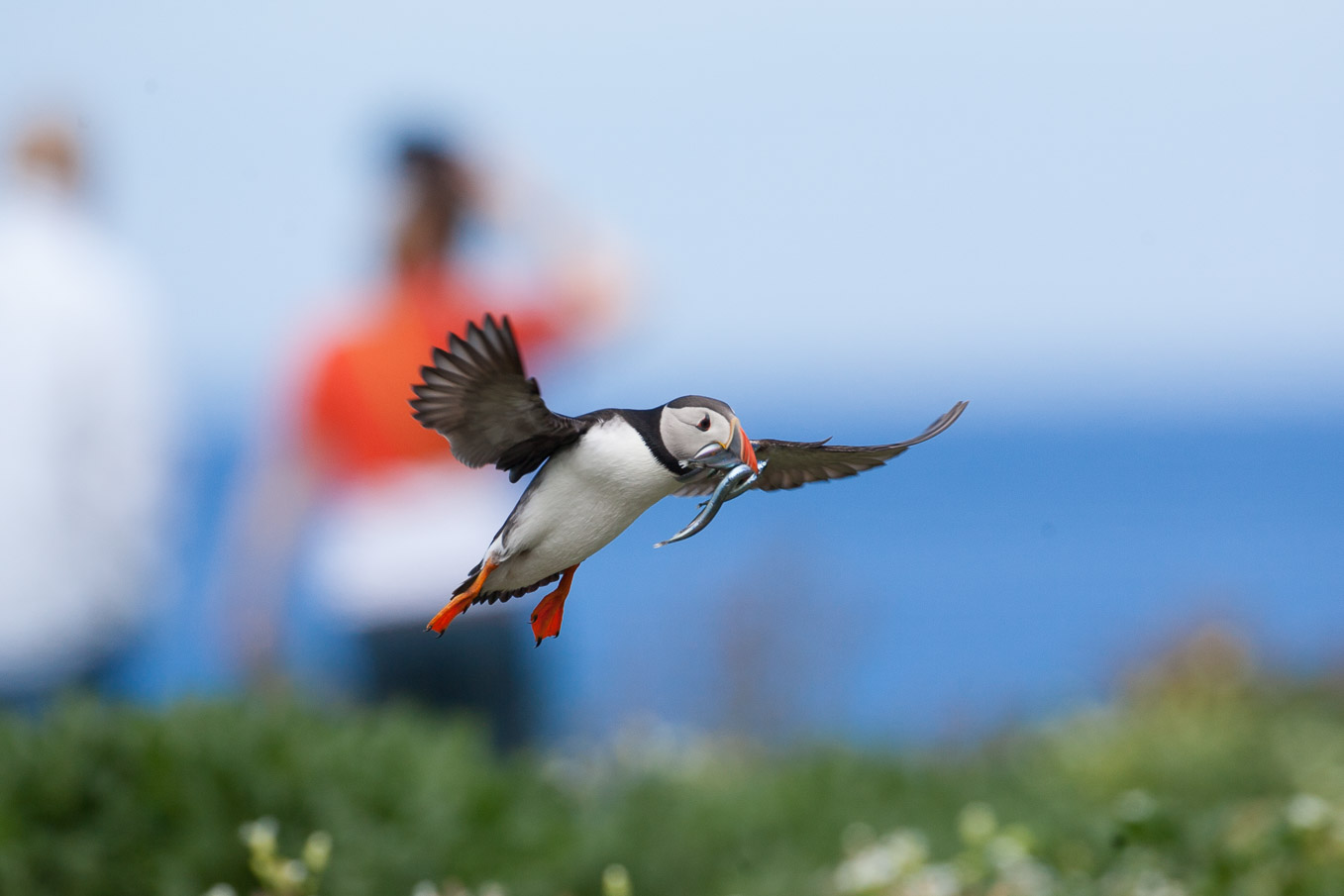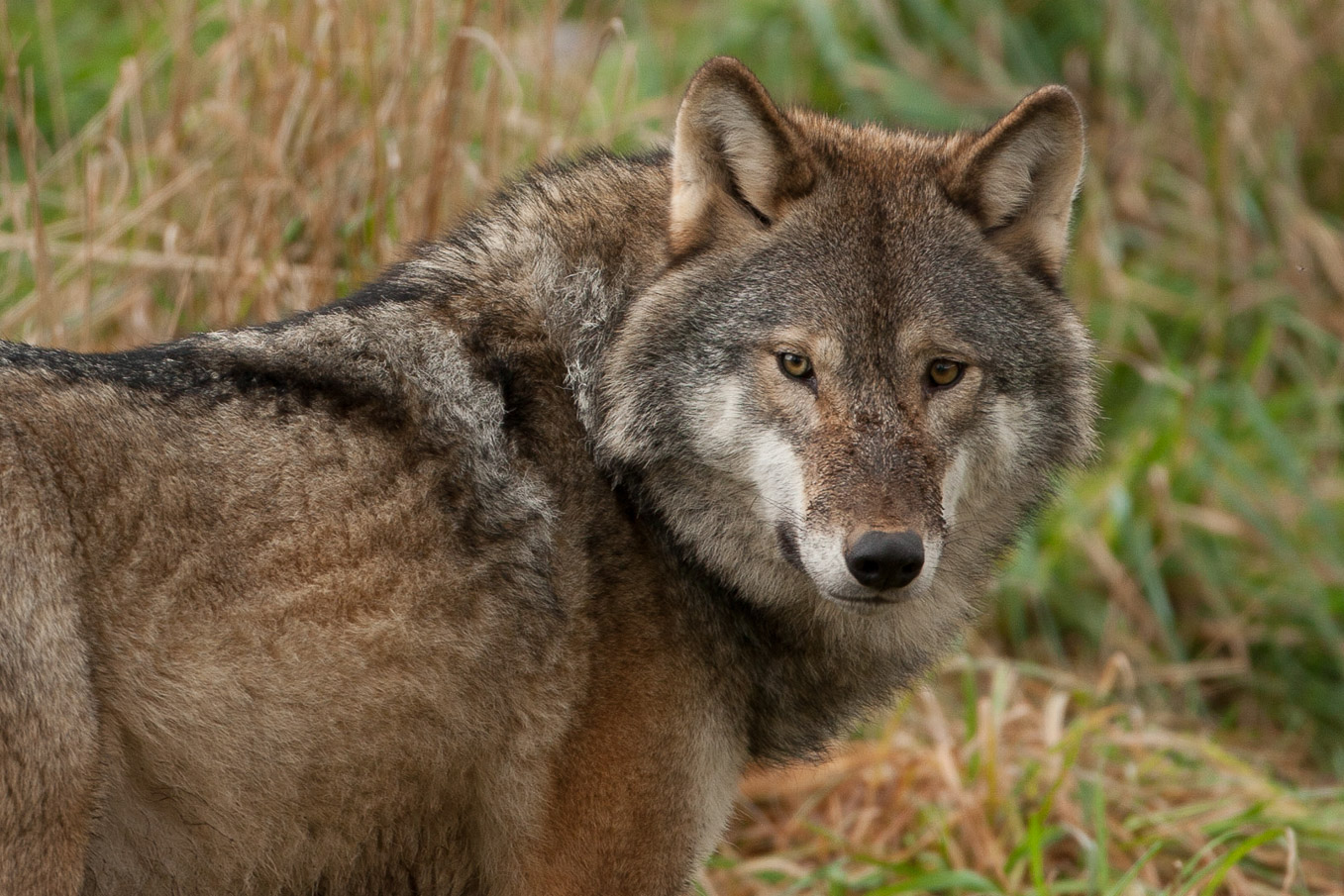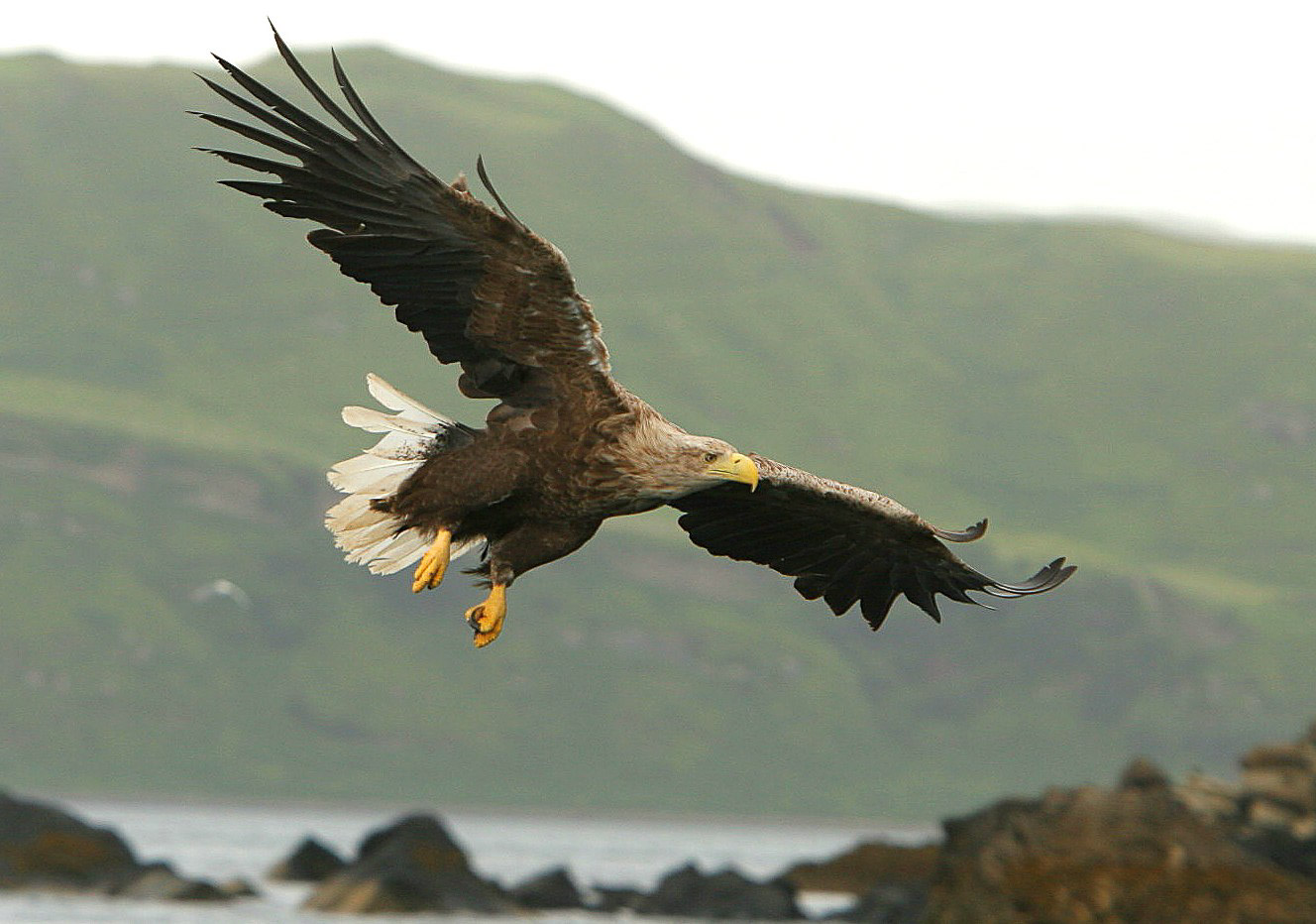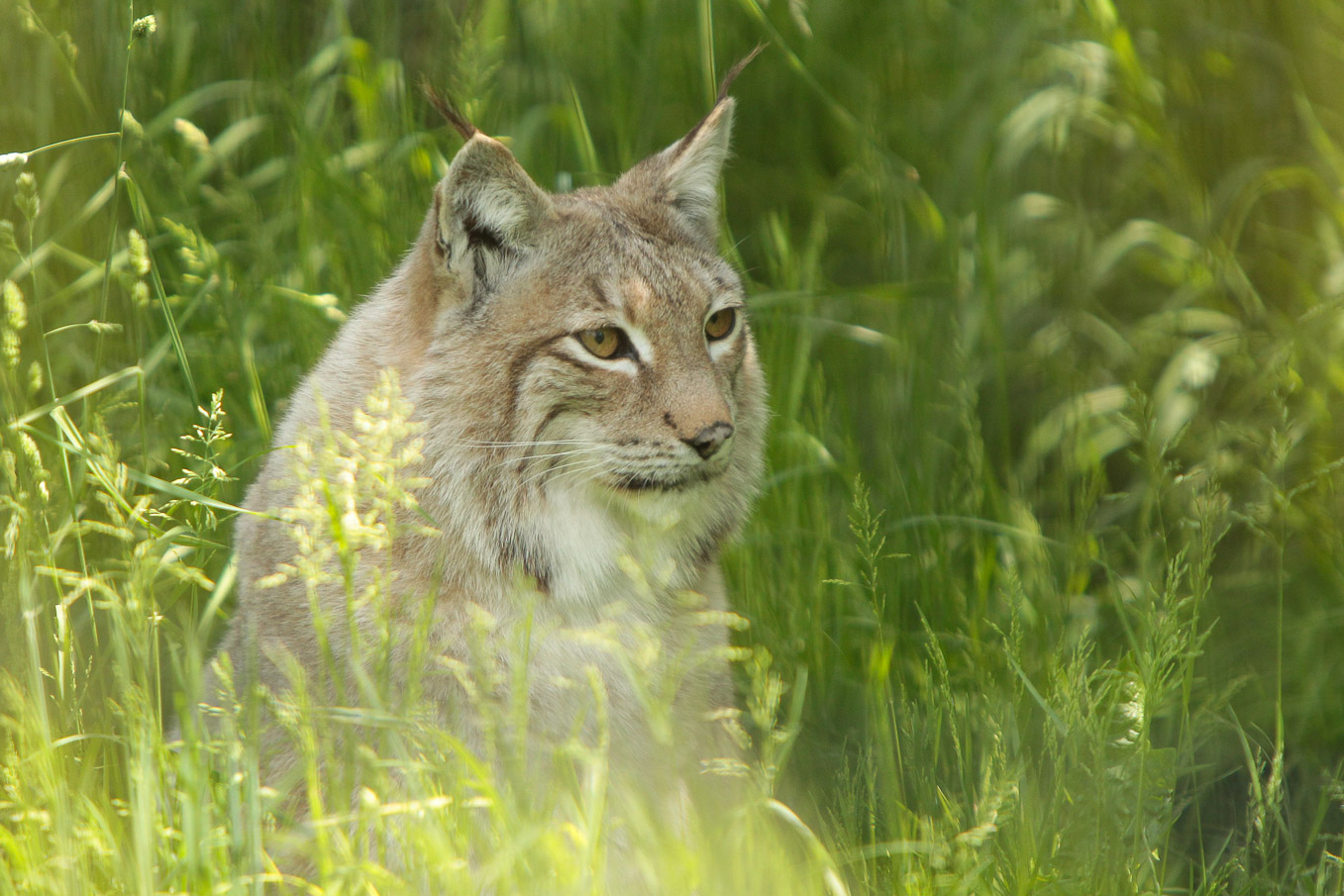
Returning our lost apex predators
Bears, wolves, lynx...can we really live alongside them once again in the UK? Hayley Kinsey outlines how and why we could and should.
History
We started interfering with the natural world pretty early on.
We kind of know this subconsciously - we’ve all seen Tony Robinson telling us that what looks like a small muddy rock is actually a Stone Age axe head on Time Team - but the reality is harsh.
We haven’t had a complete, fully-functioning ecosystem for more than 3,000 years, or even longer if you look back to when we had wild horses.
For the past 3,000 years, Britain has had what you could charitably call gaps (or accurately call huge gaping holes) in its ecosystems. If you’re stood in Britain, looking at a nice woodland or countryside scene, and thinking to yourself that you’re looking at what our landscape used to look like, or that you’re looking at some of the last original habitat or ecosystems we have, then I hate to break it to you but you’re wrong. We haven’t seen Britain’s true natural state for thousands of years, even in non-developed areas, because of the chasms we’ve created in the ecosystem.
The biggest hole in our ecosystem is our missing landscape architects. We used to have wild ox, bison, horses, boars and beavers that helped to maintain that gold standard landscape prized by nature reserves: mosaic habitat. The browsing of these grazing animals prevented the land being overtaken by dense tree cover - allowing our plant and animal life to thrive in the sunshine of meadows and expanses of wetland. With the herbivores came predators.
In the early Holocene, we had three apex predators: lynx, wolves, and brown bears. Yes, really. If you’re struggling to imagine that we had brown bears here, I hear you - don’t even get me started on the fact that we used to have elephants. The natural world we know in Britain today is nothing like the natural world that once was.
These predators aren’t all in the completely distant past - this isn’t Jurassic Park. We had brown bears until the Bronze Age, lynx in the ninth century and wolves well into the eighteenth century.
SHIFTING BASELINE SYNDROME
If the natural order of our ecosystem in Britain includes these apex predators, and we had wolves right up until a few hundred years ago, why are we only talking about them now?
It’s a valid question. When a topic has been explored for many years - like conservation - people become suspicious of new ideas. If this idea is workable, why haven’t we done this before?
A large part of the answer is shifting baseline syndrome. This describes the way that we reach for something in our own lifetime - or at least in a time of prolific record-keeping - to use as the base for ‘the wild’ that we’re trying to regenerate or recreate.
By the time we got our act together and started caring about conserving the natural world in the nineteenth century, our apex predators were long gone and nobody alive could remember them.
People focus on restoring what they know. You’ll often hear people lament that when they were younger, the sheep fields of our countryside were bordered by thick hedgerows and alive with the song of what we now call farmland birds, like skylarks and corn buntings. Someone will write a book about the ‘good old days’ when the countryside looked like it did 40 or 50 years ago and the rest of us will all pile on and do everything we can to micromanage habitats to return the specific density of species that used to appear there when our grandparents were growing up.
The issue here is probably obvious: we’re trying to restore the natural world to an already-deprived state. Yes, it was less deprived than it is now, and yes, it would certainly be preferable to return it to that state from 50 years ago rather than to leave it how it is now or allow it to get worse, but the question is: are we aiming high enough?
If we look further back, we can find the missing pieces of the jigsaw and fill in the gaps in our broken ecosystems. Not only does this allow us to return to a more true sense of nature, it also makes the whole conservation process a lot easier.
Right now, we plough millions of pounds a year into very deserving and important projects that closely manage habitats for the benefit of limited selected species. We designate some areas Sites of Special Scientific Interest and manage them exclusively for the benefit of one or two rare species - even going so far as to dictate the height the grass must be kept at in the SSSI.
The reason we need to engage in such intensive micromanagement to cling to our biodiversity is to plug the gaps left in our habitats by the absence of traditional wild grazers and apex predators. Without reintroductions that fill these gaps, there’s no end in sight to our meticulous, costly, and time-consuming way of trying to create and maintain habitat for specific species.
Shifting our baseline right the way back to when Britain last had a fully functioning ecosystem might require a bit more imagination, but it opens up a whole world of possibilities that aren’t available to us when we’re desperately trying to recreate missing elements of the natural world.
ABOUT LYNX, WOLVES AND BEARS
To understand whether, and where, we can introduce apex predators we need to know where they like to live and what they like to eat.
Lynx specialise in woodland hunting - they like denser tree cover, and are particularly good at hunting roe deer. Steep slopes are the places most likely to have had dense tree cover before we started clearing the land, because they are areas friendly to predators like the lynx but unfriendly to large herbivorous landscapers. One of the last areas lynx were recorded is the Lake District, which at the time was probably under canopy.
Before you panic that we don’t have enough dense woodland left for all these apex predators, wolves aren’t like lynx. They’re not forest-dwellers; they thrive in mosaic habitat, landscapes that include wooded areas but also open areas like meadows, and they have a varied diet.
Brown bears also like broken woodland, because they eat lots of fruit and berries - which grow on trees that get sunlight, not trees in dense canopy - and because they eat fish, so they like being by wetlands.
EFFECTS OF APEX PREDATORS
TROPHIC CASCADE
The reintroduction of animals like lynx and wolves create what is known as an apex predator trophic cascade.
Trophic level refers to the position an organism occupies in the food chain. A trophic cascade happens when the introduction or removal of one trophic level changes the abundance or behaviour of another trophic level, which releases the trophic level below from predation.
Applied to apex predators, this means that when you introduce a predator at the top trophic level, it changes the behaviour of (and to a certain extent controls the numbers of) its prey - let’s say, deer. The change to the deer’s trophic level means the level below - the plants that the deer feed on - is released from herbivory i.e. they stop getting eaten so much, which allows them to grow and regenerate.
This sets off a domino-effect (a cascade) of benefits for biodiversity - and it makes sense, if you think about it. Since the early Holocene, biodiversity has been falling - often steeply. We’re now in the midst of the Sixth Extinction. Returning to the suitable areas of the landscape elements that we have taken away can help turn back the clock to discover the thriving life of earlier times.
CONTROL OF HERBIVORE POPULATIONS
Lynx and wolves keep population numbers of herbivores and smaller predators in check to a certain extent - but they’re not the controlling element you might think they are. Most large herds of herbivores in more wild areas like the Serengeti are kept in check not by the lions but by starvation.
Having said that, they could certainly make a dint in our out of control deer populations which should be welcomed by everyone - even deer lovers and landowners who operate deer estates. Large populations of deer with no predators lead to decimation of the landscape as the deer eat shoots and saplings, but it also leads to weaknesses in the deer themselves. Studies have shown that the more deer there are, the smaller the stags and the less impressive their antlers - hence my comment that deer stalkers should be on board with reintroduction of predators. Predators take out the sick, the old, and the weak - creating smaller but stronger populations of deer.
These predators would keep in check the populations of herbivorous landscape architects but also smaller predators, like foxes and badgers, which also triggers the knock-on effects of trophic cascade. The varied and wide-ranging positive effects of apex predators depend on location and other factors, but if our 240,000-strong fox population was kept in check by wolves and lynx, it’s no real jump to imagine soaring populations of birds of prey, given there’ll be more small mammals for them to hunt if the foxy competition is fewer.
DRIVING A CHANGE IN BEHAVIOUR
Even if lynx and wolves aren’t the sole driving force for controlling population numbers, they still change the behaviour of the other animals in a way that is useful for promoting biodiversity.
Fear of predation makes grazing animals stay on the move, which prevents any particular area coming under too heavy fire from their browsing and munching. Herbivores that move around the landscape to avoid predators also spread seeds further and allow regeneration of the areas they feed in.
PROTECTING FORESTRY INTERESTS
You might think that the people who would be most resistant to the release of apex predators are foresters - but actually, it’s quite the opposite (or at least, it should be).
Lynx and wolves control the populations of deer and other browsers, which protects the trees and allows regeneration. Having them around saves money on costly fencing or culls.
THE CELEBRITY FACTOR
Like it or not, people care more about large predators than they do about most other plant and animal life.
How badly did you want to adopt a tiger when you were a kid? How many high-profile campaigns are focused on leopards and lions? If you had to list 10 animals worldwide that need our help off the top of your head, how many of them would be big cats?
Most kids aren’t desperately begging their parents to take them to see dung beetles. As beautiful and threatened as they are, nobody has started an ‘adopt a Turtle Dove’ campaign. Any campaign to save our native tree and plant life from being ravaged by deer (I haven’t seen any) hasn’t gained quite the same traction as the campaigns to save tigers from poachers.
As conservationists that care about native and lesser-known or less glamorous species that need protection and restoration, we can either sit around mad at the success of glittery campaigns for charismatic large predators, or we can use that success to argue for reintroductions in Britain that will indirectly protect those lesser-known, Z-list celebrity plants and animals that we love so much.
Anyone sponsoring a wolf, donating to a lynx reintroduction programme, watching trail cam footage online or paying to go on a safari would be indirectly donating to and benefitting the entire ecosystem that the rewilded land hosting these celebrities supports.
With their A-list status in mind, let’s look at the economic argument for reintroducing apex predators.
THE ECONOMICS
Something we need to appreciate is the economic value of natural capital. Functioning ecosystems bring myriad wide-ranging economic benefits that can be difficult to estimate or quantify and therefore difficult to use to convince people to support a reintroduction. Thankfully, there’s an obvious example of the economic benefits star-attraction wildlife can bring that’s reasonably easy to apply to the prospect of apex predators: people’s reactions to puffins.
A DETOUR TO PUFFINS
You love puffins right? I love puffins. We all love puffins. They’re cute, colourful and charismatic. They nest at several locations in Britain and here’s the thing - we love visiting them, and we pay good money to do so.
Bempton Cliffs is one place to see puffins in the UK. It sees more than 100,000 visitors a year. Visitors flock here from all over the UK and further afield to delight in the seabird colonies on this relatively short stretch of cliff face.
There are lots of other examples of VIP wildlife that attract large visitor numbers in the UK, like ospreys at Rutland Water and Loch Garten, capercaillies in the Cairngorms, and white tailed and golden eagles on the Isle of Mull - but let’s just look at the maths for the puffins to keep things simple.
100,000 people visit Bempton Cliffs each year to see the seabirds. According to the RSPB (which manages the site), the vast majority of those visitors are from outside of the local area. Let’s take a conservative estimate and say that 80% of those visitors aren’t local. Now, if each of those 80,000 visitors spends £100 on their trip, that’s £8 million for the local economy. If you’re thinking £100 seems a bit steep, I’m talking full spend here, not just spend at the reserve - so it’s actually another conservative estimate. In reality, people staying in the area to visit Bempton Cliffs are likely to spend more than £100 per head once they’ve paid for their accommodation, all their meals, their parking, any other places they visit while they’re there and the cute puffin-related memento they buy from the gift shop.
how and where to see puffins in the UK
So, star wildlife can generate upwards of £8 million a year for the local economy in visitor spend - and that isn’t counting all the jobs that the £8 million supports. This is for birds that are easy to see, that people pay a small fee to stand on a cliff edge and look at.
APPLYING THE PUFFIN NUMBERS TO APEX PREDATORS
Lynx, wolves and bears are a whole other ball game when it comes to economics. They’re elusive and this means people who want to see them (and there’ll be lots of those people) will need to stay longer and spend more in the area. There’ll be the demand for additional services, like safaris and scopes, which land owners can charge extra for.
It’s difficult to rank the celebrity value of wildlife - especially wildlife we haven’t seen in Britain for thousands of years - but judging by the intense interest in and visitors to places like Yellowstone National Park in the US we can hazard a guess that apex predators will bring in a whole lot more visitors than an (admittedly very cute) seabird. In his book Rebirding, Benedict Macdonald estimates that wolves or lynx would probably attract at least 200,000 visitors a year, and I think that’s a fair estimate.
Twice as many people are likely to come and see a pack of wolves than a pack of puffins (okay, the real collective noun for puffins is an improbability - but a pack of wolves needn’t be improbable!). On our conservative numbers, this means £16 million for the local economy - but that’s without taking into account all the safari-booking, week-long staying and binocular-buying that’s going to be going on - for apex predators, the numbers need some reworking. Macdonald’s modelling is based on osprey visitors and uses very conservative estimates of spend. Instead, let’s think about it based on realistic prices in Britain right now and compare it to our puffins.
Of 200,000 visitors, it’s reasonable to assume that at least two-thirds are going to stay more than one night in the local area. You’re unlikely to see wolves, lynx or bears on your first day (and you’d be a fool to risk it) so let’s say 133,000 people spend £200 on accommodation staying 2 or 3 nights. If they’re staying for 3 days, they need to buy 9 meals, so let’s conservatively estimate that cost at £100. The people who aren’t staying overnight will need some food too, so let’s peg them in at £20 each. Everyone who visits the reserve, visitor centre or car park (however it’s set up) will likely need to pay at least £10 entry. Let’s say the keenest quarter will want to pay extra for a special experience. Judging by the popularity of similarly priced ‘behind the scenes’ passes at the zoo, I think we can safely say some people would pay £150 for a guided safari or similar experience.
Whilst less conservative than Macdonald, I’m still keeping it real here. For every visitor with tight purse strings who lives nearby, there’s going to be several who have travelled and/or like to splash more cash - in fact, many visitors would be spending more than I’ve accounted for. They’ll also be spending money in local shops and on other local attractions that I haven’t factored in.
Even this real-world, conservative model comes to over £50 million for the local economy.
SCALING IT UP
To take Macdonald’s extension of this exercise (but my numbers), if just five of the many deer estates in Scotland (most of which currently make a loss and generate low numbers of jobs) rewilded and provided lynx safaris as well as deer stalking, the economic opportunity is more to the tune of £250 million. This doesn’t take into account the jobs created, the cost-saving in reduced spending on deer culls, and the increased income from deer stalking generated by stronger, bigger stags (as the smaller, weedier ones get taken out by the lynx).
If we scale this up to take account of apex predators at numerous locations across the country - even allowing for a slight decrease in visitor numbers as the number of sites increases (although puffins are very popular despite being in lots of places), we’re talking about a serious boost to Britain’s economy.
Taken together with the huge increase in biodiversity that this kind of rewilding would produce and all the ecosystem services provided by that biodiverse ecosystem (like carbon capture and nutrient and waste recycling), plus all the savings we’d have if the government was able to spend less on subsidising loss-making livestock farming, the economics of reintroducing apex predators are clear.
A CASE STUDY IN REWILDING GENERATING COLD HARD CASH
For a heart-warming real-life case study of how rewilding can improve our economic fortunes, you need look no further afield than Sussex, where Isabella Tree and Charlie Burrell manage the Knepp Estate.
As Tree writes in her book, Wilding, the farming estate had been loss-making (even with subsidies) for many years when they decided to take a chance on rewilding. Fast forward and the Knepp Estate is a haven for threatened wildlife and now turns a profit, with safaris proving to be very popular and it even offers overnight stays onsite. And here’s the thing - Knepp doesn’t have any VIP wildlife. It has some lesser-seen species, like the eternally lovely turtle dove, but there’s nothing glamorous - there are no apex predators.
If people are willing to pay good money to visit an estate in Sussex that supports a biodiverse ecosystem, then they’re willing to pay even better money to see long-forgotten A-List predators.
PREDATORS BRINGING IN THE CASH FURTHER AFIELD
Germany’s economy benefits from a thriving ecotourism sector to a much greater extent than Britain’s does. Why? Well, one reason is that Germany’s national parks aren’t full of sheep and dairy cows - they’re complex ecosystems with - you guessed it - wolves and lynx.
If you’re still sceptical about the revolutionary value of reintroduced predators, here’s a stat that’s hard to argue with: in Finland, ecotourist numbers increased 90% after wolverines and brown bears were re-established.
The great thing is, this huge increase in revenue from ecotourism doesn’t even have to come at the cost of revenue from other sources - land uses such as deer stalking, game shooting and livestock farming can all still take place on rewilded land.
This pattern of increased tourism and income is repeated all around the world in areas where rewilding and reintroductions have been embraced.
HAVE OTHER REINTRODUCTIONS WORKED?
Probably the most famous example of the successful reintroduction of wolves is their reintroduction to Yellowstone National Park in the US, where the wolves triggered a trophic cascade that launched the park into a new level of biodiversity.
Before the wolves were released, the deer in Yellowstone spent a long time browsing shrubs and saplings in the same area. Why would they bother themselves moving around if there was no risk of predation? This meant that areas were completely stripped of shrubbery and saplings were unable to grow in the river valleys and gorges that the deer frequented.
Enter the wolves. When the threat of predation became known to the deer, they weren’t hanging around the same spot like bored teenagers anymore. They were agile, they were quick - they were on the move, because they had to be.
Within just six years, the trees previously munched by the deer grew back - and thus began the effects of the trophic cascade. The trees shaded areas of water, allowing fish to hide and thereby improving the number and variety of aquatic life. The wolves hunted coyote as well as deer, so the coyote’s prey animals, rabbits, mice, and fox increased in population size too. This led to an increase in the number of hawks, as there were more small mammals available for the birds of prey to hunt. When cottonwood, willow and aspen thickets grew in the valleys without the destructive force of the deer, populations of woodland birds, bison and beavers increased. Even the iconic Yellowstone bears benefited from the wolves, despite not being below the wolves in the food chain; they eat fruit from trees that would otherwise have been eaten by deer, and they scavenge the remains of wolf kills.
WHERE COULD WE INTRODUCE THEM?
If you’re struggling to stretch your imagination to seeing wolves in a rewilded Snowdonia then I get it - we haven’t seen it for thousands of years, and we’ve had a long time of being taught that monoculture intensive agriculture is ‘natural’. But we do have the landscape, and we do have the space.
Lynx need large areas of woodland habitat, so we can’t just release them anywhere. The hunting range of a lynx is 8-174 square miles of woodland. The most likely candidates for lynx sites are mostly in the Scottish highlands, where there is lots of room for unbroken woodland - especially in the areas currently given over to deer stalking estates.
Releasing lynx into most of England isn’t really an option - even in areas known for tree cover, like the New Forest, we’ve broken our woodland up too much for it to be a viable habitat for lynx. Large areas of tree cover are interlaced with busy roads and cycle paths, and it seems like you’re never more than a few feet from someone’s dog - not ideal for shy forest-dwelling lynx.
Wolves, though, don’t need huge areas of dense tree cover. A wolf pack’s territory generally covers 20-120 square miles, and it will be made up of open areas as well as woodland. I’m not great at imagining distances in my head, so let’s put this into context. The Lake District National Park is roughly 912 square miles, Snowdonia is 822 square miles and the North York Moors National Park is 541 square miles. So to take just three of our national parks, we’re looking at 2,275 square miles - plenty of space for wolf packs that only require 20-120 square miles per pack.
Brown bears can and do co-exist in the same areas as wolves, so don’t need entirely separate territories or home ranges. One study found brown bear density to be 30 bears per 386 square miles of habitat - meaning at least 30 bears could fit in each of the three national parks I just mentioned.
To really drive home the point, those three national parks cover an area well over half the size of Yellowstone National Park, and Yellowstone supports 10 packs of wolves, not to mention almost 800 bears.
ARE THEY A DANGER?
Lynx certainly aren’t a danger to humans - they’re shy, solitary and elusive and there are no records of a lynx attack on humans.
Wolves aren’t a danger either - despite what Beauty and the Beast or Little Red Riding Hood might have you think, the chances that any person is ever going to be chased down by a wolf pack in Britain, even if we had lots of packs, is pretty much zero. Thankfully, the chances of a wolf killing someone’s grandma then wearing her nightdress are even lower.
You’re far more likely to be killed by a dog than by a wolf, even where wolf numbers are high. Not one single person has been killed by wolves in Europe in the last 20 years, whereas 52 people have been killed by dog bites during that time in England and Wales alone.
We let people have dogs despite the danger of attack, so the argument that we shouldn’t reintroduce wolves due to the (infinitesimally small) risk of attack doesn’t really hold.
With bears, the picture is a little more complicated. In North America, in the decade of the 1990s, bears killed 29 people. At first this looks a bit alarming, but it’s important to remember that during this decade there were 860,000 bears in North America, and there were millions of interactions between people and bears that resulted in no threat or injury. Over a similar period, dogs killed 250 people in North America - so the chances of being killed by a bear are still significantly smaller than being killed by a dog.
WILL THEY EAT SHEEP?
One of the most common (or perhaps just the most vocal) objections to the reintroduction of predators is the risk that they will predate livestock like sheep or cattle, or that they’ll eat game.
Before we even address this argument, let’s remember the huge economic potential of these predators outlined above. The context here is that a huge proportion of farms - and indeed much of our sheep agriculture - is loss-making as it is, and is supported by subsidies.
On a broader scale, we need to think about the future of farmland in Britain. Farming is important in both personal and cultural history and is deeply valued by many people. I don’t think any people advocating for the return of our lost predators and for the rewildling of our land are also advocating for completely wiping traditional farming from our land, but we do have to take a realist view - while being sensitive to the cultural importance of farming.
Many projections predict that much of the farmland in Europe will be abandoned in the coming decades, and as more people move to a meat-free diet, use of land for raising livestock will decrease and will not be matched by land use for growing plant-based food, as raising livestock takes up significantly more space. There are predictions that the abandonment of farmland in the UK will be accelerated by the loss of farming subsidies from the EU as a result of Brexit. Whilst farming is an important way to make a living for lots of people, the real picture shows many farmers struggling to make ends meet and the number of jobs provided by farming has been declining for decades. The economic value of our livestock industry has been falling over time and if we’re to protect farmers from the negative effects of the declining market we must look to alternative land uses that generate stronger economic value whilst retaining important cultural and lifestyle elements of our farming.
But in answer to the question - no. Where predators are present in Europe they do occasionally clash with farmers, but the reports of predation don’t add up to something that would threaten an industry, even more so if you discount deaths of livestock reported as being by apex predators when the evidence suggests otherwise.
To turn to the numbers, in an assessment of the predation rates for sheep by lynx across Europe, the rate of kills per lynx per year was in almost all cases zero or less than one - averaging out across 20 countries at 0.9 sheep killed per lynx per year. So that’s a resounding no - lynx don’t threaten livestock.
Wolves are the more likely candidate for posing a threat to livestock, because they like to hunt out in the open - but the numbers are reassuring here too. In Finland, which has a healthy wolf population, only 45 sheep were killed by wolves in six years. Other studies have shown that wolves prefer wild prey and that they do not kill significant numbers of livestock.
The risk of predation by wolves is even lower for traditional sheep farming techniques, such as shepherding and nomadic practices - so the reintroduction of wolves could prompt a move away from intensive penned-in farming practices to culturally and historically valued mixed-use land where sheep are grazed nomadically in lower concentrations, with additional income derived from ecotourism and associated opportunities.
ISN’T THIS A BIT CRAZY?
If you read criticism about the idea of reintroducing apex predators to Britain, you’ll come across the name Jurassic Park a lot. Commentators seem to think they’re presenting a killer argument against reintroductions when they say that ‘it would be like Jurassic Park’ but really they’re just showing their lack of understanding.
Leaving aside the obvious fact that Jurassic Park is about bringing dinosaurs back from extinction and we’re talking about reintroducing animals that still exist and have co-existed with humans in Britain in the past, the comparison seems to ignore the context that in many places today the presence of apex predators is normal.
To describe reintroduction of predators as ‘like Jurassic Park’ suggests that it would be outrageous, dangerous, unpredictable and revolutionary - but it isn’t. One third of mainland Europe has brown bears, wolves, lynx and wolverine.
If you’ve got the stamina, let’s look at a couple more numbers - I promise they’re the last set!
There are currently around 9,000 lynx in 23 European countries, some of which are the result of successful reintroductions in Switzerland, Germany, Slovenia, Spain and Portugal.
There are also roughly 12,000 wolves, 17,000 brown bears and 1,250 wolverines in Europe, so we don’t need to look back to the age of the dinosaurs to imagine these animals living wild in our landscape.
The point is, we’re lagging behind. We’re the slowest country in Europe to hop on the reintroduction bandwagon, and that’s probably a contributing factor to why we have the unsavoury accolade of being the European country that has pushed the most species to the brink of extinction.
HOW CLOSE ARE WE?
How close we are to instigating a reintroduction of apex predators depends who you talk to, but there are positive signs that we’re moving in the right direction.
Conservation organisations like Rewilding Britain are in support of reintroducing lynx to England and Scotland when a viable reintroduction programme is proposed.
There are people keen on wolves too, like Paul Lister who owns the Alladale Wilderness Reserve, a rewilding project in the Scottish Highlands and who wants to introduce wolves to his land to control the spiralling deer over-population problem and to generate ecotourism opportunities.
There are caveats to the current plans, just like there are with the beaver introductions. We’re understandably nervous about releasing reintroduced species, so the lynx will be closely monitored with GPS tags for the trial period, and the wolves of the Alladale estate would be released in a (very) large fenced area.
Bears is a different story. At the moment, there are no applications to release bears in Britain - this is perhaps because of the higher number of bear attacks or because of habitat and food supply concerns. However, there are promising signs. Projects like Bear Wood by the British Zoological Society - where bears, wolves, lynx and wolverines are released into a very large enclosure - encourage people to think of bears as part of our (relatively) recent history and remind us that these top predators used to coexist in our landscape.
Support seems to be growing, and I hope that it’s sooner rather than later that Defra grant the licences necessary to reintroduce these majestic creatures, so that they can join other successful reintroductions in our ecological hall of fame like the white tailed eagle, which has been successfully reintroduced to both Scotland and the Isle of Wight.
LOCAL ENGAGEMENT: A KEY FACTOR FOR SUCCESS
I would go as far as to say that the most important factor for the success of any scheme to reintroduce our apex predators is local engagement and support.
It seems blindingly obvious that conservationists should seek the views of and reassure local people before embarking on reintroduction projects but it’s not always the approach taken, and this can generate frustration and animosity - as well as the project potentially missing opportunities for improvement.
Misinformation about reintroduction is a serious problem. The reality is that almost all landowners and land users will either benefit from or experience no negative effect from the reintroduction of large predators - but people don’t know this unless we tell them. Just look at the outrage some anglers generate about beavers ‘eating all the fish’ (they’re herbivores and actually increase fish numbers).
The information explained in this post about the economic benefits of predator reintroduction and myth-busting around their supposed dangers is not common knowledge and it’s not intuitive.
Another significant issue in terms of local engagement is counter-productive confrontation between conservationists and land owners, estate managers and farmers. As I explained when discussing the historical and cultural value and importance of farming, and the ability we have to maintain that whilst also rewilding and reintroducing, the interests of conservationists and land users are not diametrically opposed. It is natural for land users to be nervous or defensive regarding proposed changes to land use in Britain and it’s also natural for conservationists to feel frustrated with certain types of land use that contribute to the decline of our biodiversity, but this doesn’t mean that there are two sides and it doesn’t necessitate conflict. What we need is to present arguments that value and benefit all participants.
If we take the time to patiently and logically address queries or concerns and lay out the economic arguments for reintroduction alongside the ecological arguments, I’m confident that the public will get on board and that we’ll be able to join other European countries in kickstarting our biodiversity recovery by introducing celebrity predators like wolves, lynx and bears.
Maybe I’ll see you on a Scottish lynx safari sometime soon!
Hayley Kinsey is a Popular science and conservation writer and wildlife photographer, read more of her articles at her website Hayulls.com and find her on twitter @hayulls and instagram hayulls
RESOURCES
Brown Bear images by Ashley Grove Wild Images
Reintroduction of Top-Order Predators, M Haywood, M Somers, 2009, John Wiley & Sons
Kaartinen, S., Luoto, M. & Kojola, I. Carnivore-livestock conflicts: determinants of wolf (Canis lupus) depredation on sheep farms in Finland. Biodivers Conserv 18, 3503 (2009). https://doi.org/10.1007/s10531-009-9657-8
Mammal Review. 2004, Volume 34, No. 3, 211–232. Printed in Great Britain.
Could we live with reintroduced large carnivores in the UK? CHARLES J. WILSON
WILDING, TREE, I., 2019. PICADOR.
REBIRDING. MACDONALD, B., 2020. PELAGIC PUBLISHING.
Bear attacks. 3rd ed. Herrero, S., 2018.
Milleret, C., Ordiz, A., Chapron, G., Andreassen, H., Kindberg, J., Månsson, J., Tallian, A., Wabakken, P., Wikenros, C., Zimmermann, B., Swenson, J. and Sand, H., 2018. Habitat segregation between brown bears and gray wolves in a human-dominated landscape. Ecology and Evolution, 8(23), pp.11450-11466.
Alladale Wilderness Reserve: https://alladale.com
Rewilding Britain: https://www.rewildingbritain.org.uk
